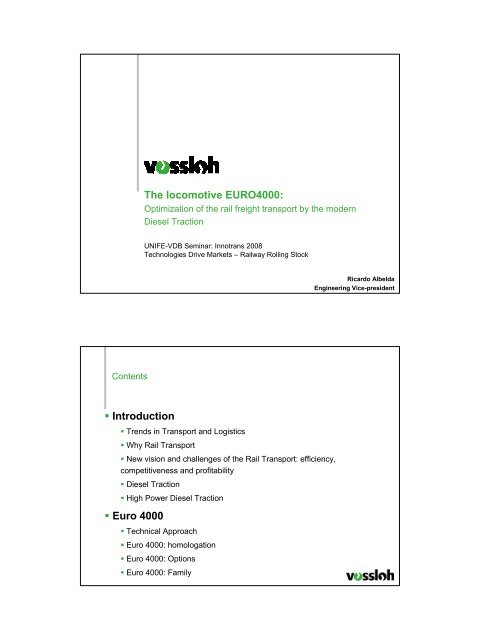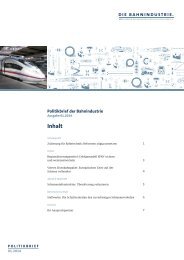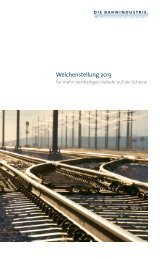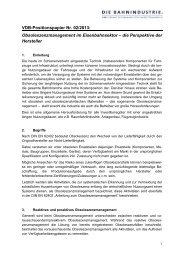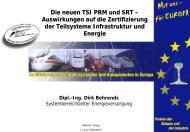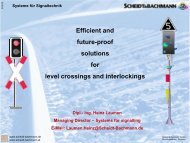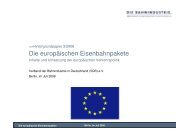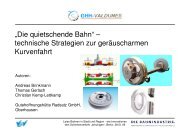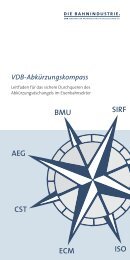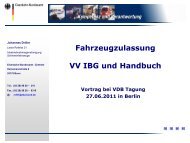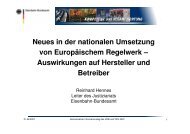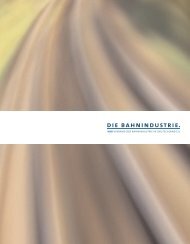The locomotive EURO4000: Introduction Euro 4000
The locomotive EURO4000: Introduction Euro 4000
The locomotive EURO4000: Introduction Euro 4000
Create successful ePaper yourself
Turn your PDF publications into a flip-book with our unique Google optimized e-Paper software.
Contents<br />
<strong>Introduction</strong><br />
<strong>The</strong> <strong>locomotive</strong> <strong>EURO<strong>4000</strong></strong>:<br />
Optimization of the rail freight transport by the modern<br />
Diesel Traction<br />
UNIFE-VDB Seminar: Innotrans 2008<br />
Technologies Drive Markets – Railway Rolling Stock<br />
Trends in Transport and Logistics<br />
Why Rail Transport<br />
New vision and challenges of the Rail Transport: efficiency,<br />
competitiveness and profitability<br />
Diesel Traction<br />
High Power Diesel Traction<br />
<strong>Euro</strong> <strong>4000</strong><br />
Technical Approach<br />
<strong>Euro</strong> <strong>4000</strong>: homologation<br />
<strong>Euro</strong> <strong>4000</strong>: Options<br />
<strong>Euro</strong> <strong>4000</strong>: Family<br />
Ricardo Albelda<br />
Engineering Vice-president
Background:<br />
► Increasing globalization<br />
► New production techniques:<br />
outsourcing<br />
► Offshoring<br />
► <strong>The</strong> new global production areas in<br />
China and Southeast Asia<br />
► Expansion of tourism<br />
► Increase in consumer demand of:<br />
exotic products, fresh fruit<br />
<strong>Introduction</strong><br />
Trends in transport and logistics<br />
<strong>Introduction</strong><br />
Trends in transport and logistics<br />
► High logistic costs for the companies<br />
► Congestion on highways<br />
► Accidents<br />
► <strong>The</strong> growing social awareness of the environment: Energy<br />
efficiency, climate change, emissions and noise…<br />
Urgent need for more efficient logistics and a more<br />
intelligent and sustainable transport.<br />
Trends:<br />
<strong>The</strong> international freight transport growth<br />
rate is above the GDP growth rate:<br />
► More freight transported<br />
► More areas covered
<strong>Introduction</strong><br />
Why Rail Transport<br />
Energy<br />
Consumption<br />
Emissions<br />
Climate<br />
Change<br />
External<br />
Costs *<br />
Growing<br />
Demand<br />
Safety<br />
TRANSPORT CHALLENGES RAIL CONTRIBUTION<br />
30% of total energy consumption.<br />
98% dependent on oil<br />
Increased by 34.9% since 1990, while in other<br />
sectors decreased by 3.1%.<br />
Transport is responsible of >25%<br />
of total CO2 emissions<br />
EU transport related pollution costs €160 billion<br />
per year (€360 per year per citizen).<br />
Since 1995, annual growth rates in EU27 were 1.7<br />
for Passenger Transport and 2.8 for Freight.<br />
Increasing Energy Consumption, Congestion<br />
and Land Use.<br />
Specially concern in road transport (fatalities,<br />
accidents)<br />
Rail is the most efficient transport mode. It uses 3 -<br />
6 times less energy than road to transport the same<br />
amount of tons.<br />
Rail is the most environmentally friendly mode of<br />
transport. In freight transport, rail emissions are below<br />
a third of those of an average truck.<br />
Rail share of total GHG Emissions from EU Transport<br />
is only 0.6%<br />
Cost Externalities of rail freight are bellow a quarter<br />
of those for road freight<br />
Modal shift to rail will diminish Energy<br />
Consumption, Road Congestion and Land Use: A<br />
double track railway connection has the same<br />
transport ability as a 16-lane superhighway with 8<br />
lanes in each direction<br />
Number of accidents involving personal injury is much<br />
less in rail than in road transport<br />
* In terms of accidents, air pollution, climate change, noise, and deterioration of landscape, habitats and the urban environment.<br />
Co-operation between all transport modes is essential; railways as the most efficient and<br />
sustainable mode, must play an important roll in Transport Policies and Globalization.<br />
<strong>Introduction</strong><br />
New vision and new challenges of the rail transport:<br />
efficiency, competitiveness and profitability<br />
Despite <strong>Euro</strong>pean regulations and political communities, the main challenge for railway<br />
transport to increase its market share is:<br />
To come closer to the priorities of the final client:<br />
► Reliable transport<br />
► Competitive costs<br />
► Security of the load<br />
► Management of information<br />
► Time required in the transport and<br />
the loading/unloading<br />
► Frequency of transport<br />
► Ecological aspects<br />
Offer:<br />
► Quality of service<br />
► Efficiency<br />
► Security<br />
► Competitive costs compared to<br />
roadways<br />
► Reduction of environmental<br />
damage<br />
6
<strong>Introduction</strong><br />
New vision and new challenges of the rail transport:<br />
efficiency, competitiveness and profitability<br />
Demands of the operators:<br />
1. Reliability of the <strong>locomotive</strong>s<br />
2. Low costs of maintenance and operation<br />
3. Flexibility<br />
4. <strong>Introduction</strong> of new technologies:<br />
► Control systems<br />
► Information and communication systems, etc.<br />
5. Movable equipment capable to carry more cargo:<br />
► Locomotives with great drag ability,<br />
► With technologies that enable the formation of long trains,<br />
► Low tare and great resistance wagons to lift more tonnes, etc.<br />
6. Compliance with <strong>Euro</strong>pean and national standards: crash, noise,<br />
emissions, comfort of the cabin…<br />
7. Approval of the material in the different countries where they circulate<br />
8. Easy in crossing borders with interoperable material and with<br />
agreements between countries<br />
<strong>Introduction</strong><br />
Diesel – Electric Rail Traction.<br />
Diesel Infrastructure and Operation Advantages.<br />
► Infrastructure price reduction, both in investment and in maintenance.<br />
► No electromagnetic disturbances.<br />
► System no affected by an overhead line fail or a cut of tension.<br />
► Simplifications of the loading/uploading operations in terminals.<br />
► Flexibility of operation, can go anywhere.<br />
► Double-stack containerization.<br />
► Environment: New emissions technology required for NRMM will make diesel<br />
<strong>locomotive</strong>s cleaner. Electric are only clean in the point of use. Much better visual impact<br />
than an electrified line.<br />
► Top speed of freight trains is 120km/h (140km/h in exceptional cases), therefore<br />
electrification is not needed. <strong>The</strong> advantages of electric <strong>locomotive</strong>s begin at higher speed.<br />
Improving productivity<br />
and competitiveness
<strong>Introduction</strong><br />
Diesel – Electric Rail Traction.<br />
Network Interoperatibility issues<br />
<strong>Introduction</strong><br />
Diesel – Electric Rail Traction.<br />
Electrified Railway Lines<br />
100<br />
90<br />
80<br />
70<br />
60<br />
50<br />
40<br />
30<br />
20<br />
10<br />
0<br />
Average in EU27:<br />
49,8%<br />
Belgium<br />
Bulgaria<br />
Czech Republic<br />
Denmark<br />
Germany<br />
Estonia<br />
Ireland<br />
Greece<br />
Spain<br />
France<br />
Italy<br />
Cyprus<br />
Latvia<br />
Lithuania<br />
Luxembourg<br />
Hungary<br />
Malta<br />
<strong>The</strong> Netherlands<br />
Austria<br />
Poland<br />
Portugal<br />
Romania<br />
Slovenia<br />
Slovak Republic<br />
Finland<br />
Sweden<br />
United Kindogm<br />
Croatia<br />
FYRM<br />
Turkey<br />
Iceland<br />
Norway<br />
Switzerland<br />
Source: UIC Statistics, 2003<br />
Diesel provides<br />
Greater flexibility<br />
Diesel is essential in half<br />
of EU railway lines<br />
Source: Energy & Transport in figures, 2007. EC,<br />
Directorate General Energy and Transport<br />
Diesel is essential in most<br />
worldwide railway lines
<strong>Introduction</strong><br />
High Diesel Rail Traction Power<br />
High diesel traction power is required to:<br />
► Increase high diesel power product range and<br />
give customers more choices according to their<br />
operation necessities and network operatibility<br />
issues.<br />
► Increase load capacity less fleet required for<br />
the operator reduce managing costs, personnel<br />
costs and maintenance costs.<br />
► Diminish fuel consumption per ton-km (costs per<br />
ton-km go down as haul increases)<br />
Effective Tractive Effort(kN)<br />
400,0<br />
350,0<br />
300,0<br />
250,0<br />
200,0<br />
150,0<br />
100,0<br />
50,0<br />
Locomotive Performance Comparison<br />
Heavier Heavier trains trains<br />
at at same same speed<br />
speed<br />
Higher Higher speed<br />
speed<br />
with with same same train<br />
train<br />
load<br />
load<br />
0,0<br />
0 20 40 60 80 100 120 140<br />
Speed (km/h)<br />
Loco1600kwRimPower<br />
Loco2660RimPower
EURO <strong>4000</strong><br />
Design Objectives<br />
To design a 6-AXLE DIESEL-ELECTRIC Locomotive ...<br />
... that carries the MAXIMUM LOAD possible,<br />
... runs at the HIGHEST SPEED possible,<br />
... with the LOWEST OPERATING COST possible,<br />
... in order to offer our customers the WIDEST RANGE OF OPERATION.<br />
EURO <strong>4000</strong><br />
Design Objectives. Compliant with EU Regulations<br />
... that includes <strong>Euro</strong>pean superior comfort standards<br />
EU Standards compliance<br />
• Noise emissions: TSI CR Noise 01/06-ST05<br />
• Exhaust emissions: EU 97/68 Stage IIIA (EPA Tier II eq)<br />
• Front side crash protection: EN15227:2008<br />
• Carbody Structure in accordance with EN12663<br />
• 2 cabs based on UIC 651 & DIN 5566<br />
• Integrated <strong>Euro</strong>pean driver’s desk (central position)<br />
• Cab visibility: UIC 651<br />
• Front window impact: UIC 651 (360 kph projectile speed)<br />
• Bogie frame design and test EN13749 (UIC 615-4)<br />
• Wheel EN13262, EN13979-1<br />
• Wheel sets EN13260<br />
• Axles EN13261, EN13104<br />
• Fire: DIN 5510<br />
• Axle box Bearing: EN12080, EN 12081<br />
Design-proven product<br />
• Built using standard EMD<br />
components<br />
• Fully proven in commercial<br />
service<br />
• Existing in thousands of<br />
<strong>locomotive</strong>s worldwide<br />
• No obsolescence
EURO <strong>4000</strong><br />
General Arrangement<br />
EURO <strong>4000</strong><br />
Carbody Structure<br />
► Light integral body<br />
► Welded monocoque car-body<br />
► Crashworthiness EN 15227:2008<br />
► Designed for suspended cabs<br />
1) Central desk<br />
2) Air conditioning<br />
3) Dust bin blower<br />
4) Inertial filter<br />
5) Traction generator<br />
6) Dynamic brake fan<br />
7) Diesel engine filter<br />
8) Silencer<br />
9) Water tank<br />
10) Oil cooler<br />
11) Radiators fan<br />
12) Radiators<br />
13) Bogie<br />
14) Diesel engine<br />
15) Fuel tank<br />
16) Main air reservoir<br />
17) Traction motor fan<br />
– Traction<br />
generator fan<br />
18) Sanding box<br />
19) Compressor<br />
20) Brake unit<br />
21) Electrical cabinet<br />
22) Bogie
EURO <strong>4000</strong><br />
Cab Design<br />
► New ergonomic and high comfort driver cab<br />
► Reduced noise and vibration<br />
► Auxiliary control desk next to both sliding side windows (opt.)<br />
► Air-conditioning<br />
► Refrigerator cabinet<br />
► 230 V AC sockets<br />
EURO <strong>4000</strong><br />
Powered with EMD Technology: Diesel Engine<br />
► EMD 16-710 Engine is a well proven technology<br />
Over 2,600 engines produced<br />
Largest Single Locomotive Order in history<br />
– 1000 SD70Ms<br />
EURO <strong>4000</strong> uses the same engine and<br />
alternator as SD70M<br />
Meets EPA, UIC and EU Emissions<br />
Regulations
EURO <strong>4000</strong><br />
Powered with EMD Technology: Main Alternator<br />
► EM 2000 AC-DC Locomotive control<br />
► Isolated electrical cabinet<br />
► Over 4,100 D43 traction motors in service<br />
► Over 2,000 AR 20 alternators produced.<br />
► Set of alternators mechanically linked but electrically<br />
independent<br />
Main - Auxiliary – HEP<br />
Freight: AR20 + CA6<br />
Passengers: AR11 + CA6 + HE8<br />
► HEP: 450 kVA, AC 1000V, 1-ph 22 Hz<br />
► 2 rectifiers<br />
► Single bearing equipment<br />
EURO <strong>4000</strong><br />
Powered with EMD Technology: Traction Systems<br />
Traction Motor D43<br />
► Current: DC<br />
► Ventilation: Forced<br />
► Number: 6<br />
► Connection: Parallel<br />
► Assembly: Nose Suspended
EURO <strong>4000</strong><br />
Diesel Auxiliary Systems<br />
► Separate accessory rack<br />
► Preheating system<br />
Webasto<br />
► Electrical pre-lube system<br />
► Simplified maintenance.<br />
EURO <strong>4000</strong><br />
Brake System<br />
► Microprocessors controlled UIC brake system<br />
Direct brake<br />
Spring loaded parking brake<br />
Service brake<br />
Emergency brake<br />
► Dynamic Brake<br />
600 Amp<br />
1600 kW power capability<br />
► Passenger version<br />
Blending function<br />
EP, NBÜ Brake according to UIC 541-5
EURO <strong>4000</strong><br />
Cooling System<br />
► Removable hatch with 2 cooling fans<br />
► Split cooling system:<br />
Water Jacket and Aftercooler<br />
► Antifreeze<br />
► Link Valve<br />
► External Shutters<br />
EURO <strong>4000</strong><br />
Air Filtration and Ventilation Systems<br />
► Centralized ventilation system<br />
► Two filtration stages<br />
Primary<br />
− Inertial Filters<br />
Secondary<br />
Fine filters<br />
− Diesel Engine<br />
− Electrical cabinets<br />
− Air compressor
EURO <strong>4000</strong><br />
Safety Systems: Foreseen for Different Countries<br />
► Germany: Indusi IR60 (PZB)<br />
► Belgium: Memor/<strong>Euro</strong> TBL<br />
► France: KVB<br />
► Other safety systems upon request. For example: ETCS<br />
EURO <strong>4000</strong><br />
Truck Design<br />
► Low maintenance bogie<br />
► Standard components<br />
► Cannon-box system<br />
► Mechanical transverse guidance<br />
► Welded Frame<br />
► Nose suspended traction motors<br />
► <strong>The</strong> Netherlands: ATBL- NL<br />
DESCRIPTION<br />
UNIVERSAL Co BOGIE FOR<br />
DIESEL LOCOMOTIVES<br />
FREIGHT AND<br />
PASSANGER SERVICES<br />
► Spain: ASFA<br />
MOTOR BOGIE FOR A Co’Co’ DIESEL - ELECTRIC<br />
LOCOMOTIVE.<br />
► SPEED: 120-160 Km/h (75-100 MPH)<br />
► ELECTRO-PNEUMATIC AND DISC BRAKE<br />
► GAUGE: 1,435 mm (opt. 1,668 mm)<br />
► WHEELBASE: 3,600 mm<br />
► BOGIE WEIGHT: 20.5 T.<br />
► WHEEL DIAMETER : 1,067 mm
EURO <strong>4000</strong><br />
Freight & Passenger versions<br />
BASIC CHARACTERISTICS<br />
Locomotive<br />
Axle Arrangement Co'Co'<br />
Gauge 1.435 mm<br />
Weight 123 Tn<br />
Maximum Speed 120 km/h<br />
Brake System UIC Electropneum.<br />
Structure Monocoque<br />
Number of Cabs 2<br />
Starting Effort 400 kN<br />
Min. Negotiable Curve 100 m<br />
Fuel Tank 7.000 l<br />
Múltiple Unit<br />
Diesel Engine<br />
27 PIN<br />
Manufacturer EMD<br />
Model 16-710 G3C-T2<br />
UIC Power 3.178 kW<br />
Number of Cylinders V16 (45º)<br />
Bore & Stroke 230,19 mm x 279,4<br />
mm<br />
Nominal Speed<br />
Traction Drive<br />
900 rpm<br />
Main Generator AR20<br />
Auxiliary Generator CA6<br />
Traction Motor D43TRC<br />
Traction Motor Connection Parallel<br />
Dynamic Brake<br />
600 Amp<br />
EURO <strong>4000</strong><br />
Freight & Passenger Performances<br />
Tractive Effort (kN)<br />
425<br />
400<br />
375<br />
350<br />
325<br />
300<br />
275<br />
250<br />
225<br />
200<br />
175<br />
150<br />
125<br />
100<br />
75<br />
50<br />
Tractive Effort / Speed CURVE<br />
<strong>4000</strong> HP LOCOMOTIVE<br />
71:18 GR - 1067 mm WH<br />
UIC CONDITIONS<br />
AR20 GENERATOR<br />
6 D43 TRACTION MOTORS<br />
16-710 G3B ENGINE<br />
25<br />
Tolerance : ± 3 %<br />
0<br />
0 10 20 30 40 50 60 70 80 90 100 110 120<br />
Speed (km/h)<br />
BASIC CHARACTERISTICS<br />
Locomotive<br />
Axle Arrangement Co'Co'<br />
Gauge 1435 mm<br />
Weight 126 Tn<br />
Maximum Speed 160 km/h<br />
Brake System UIC Electropneum.<br />
Structure Monocoque<br />
Number of Cabs 2<br />
Starting Effort 325 kN<br />
Min. Negotiable Curve 100 m<br />
Fuel Tank 6.000 l<br />
Múltiple Unit<br />
Diesel Engine<br />
ZWS<br />
Manufacturer EMD<br />
Model 16-710 G3C-T2<br />
UIC Power 3.178 kW<br />
Number of Cylinders V16 (45º)<br />
Bore & Stroke 230,19 mm x 279,4<br />
mm<br />
Nominal Speed<br />
Traction Drive<br />
900 rpm<br />
Main Generator AR11<br />
Auxiliary Generator CA6<br />
Traction Motor D43TRC<br />
Traction Motor Connection Parallel<br />
Dynamic Brake 600 Amp<br />
HEP Generator HE8 - 450 kW,<br />
1000V 22/50 Hz
EURO <strong>4000</strong><br />
Homologation and Cross-border Operatibility.<br />
► Homologation process already started for the following countries:<br />
Spain (finished)<br />
Germany<br />
Holland<br />
Belgium<br />
Portugal<br />
► Cross-Border operability:<br />
Sweden<br />
Norway<br />
France<br />
Poland<br />
Germany-Belgium-Netherlands<br />
Spain-Portugal<br />
Germany-Netherlands-Poland<br />
Germany-Belgium-France<br />
Sweden-Norway<br />
► Other Countries and Cross-border configurations available upon<br />
customer’s request.
EURO <strong>4000</strong><br />
Options<br />
Xenon<br />
Toilet<br />
Lights HEP<br />
Auxiliary<br />
Power<br />
Unit<br />
160<br />
km/h<br />
Remote<br />
Control<br />
EURO <strong>4000</strong> Family<br />
Light<br />
Weight<br />
From 19 to 22<br />
ton/axle<br />
Winterization<br />
Package TWC<br />
Particle<br />
ERTMS<br />
Wayside<br />
Power<br />
Supply<br />
Filter<br />
(Stage IIIB)<br />
Power<br />
From 3000<br />
to 4500 HP<br />
and<br />
From 120<br />
to 200 km/h<br />
more<br />
…<br />
Speed
EURO <strong>4000</strong><br />
Thank you!!!


